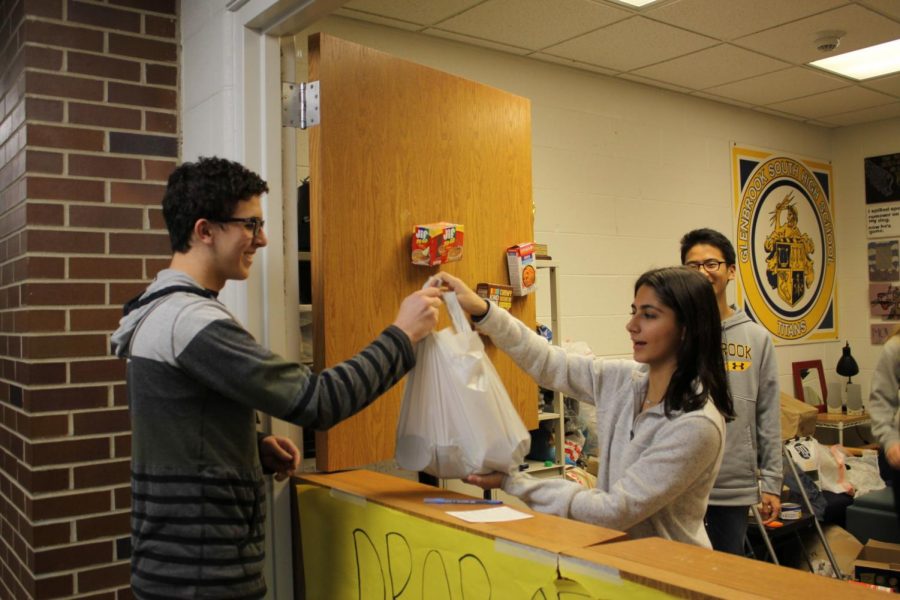The extra step: food drive cans numerical goals
Handing Laya Anvari, senior class representative, a bag of donations for the Food Drive, senior Ben Kalish helps provide supplies for 568 families around the community. The food drive underwent a number of changes this year to emphasize the humanitarian aspect behind the donations.
December 20, 2019
From shelves stocked full of beans, corn, and other low-demand products to students putting money and little thought behind their donations, Josh Koo, assistant principal of student activities, saw many shortcomings with previous food drives at South. However, by addressing past problems with the food drive, Koo brought a new take to this South tradition.
This year, quality was emphasized over quantity, Koo said. Apart from cans, Student Council collected items ranging from diapers to pasta to donate to both the Northfield Township Food Pantry and Onward House, a Chicago organization dedicated to providing education and other services. To reflect this variety, the “Canned Food Drive” was renamed the “Food Drive” to encourage students to see the broader scope of possible donations, Koo said.
“[Student Council] took out the word ‘canned’ because a lot of the goods we get are in boxes,” Koo said. “That’s just one small step that we’re taking.”
Student Council also updated last year’s point system, under which items were assigned “point values” based on demand, Koo explained. After meeting with representatives from the pantry, all items were assigned a value between zero and four.
“It’s a creative way to make our donation intentional,” Koo said. “If we make a [high demand product] four points, more of it will come. We can make our donations go a longer way.”
Rich Synek, a volunteer at the pantry, works with other volunteers to organize the multiple bus loads of food brought to the pantry from South. Normally, the pantry runs out of shelves to store all of the donations.
“It’s a big challenge, that’s for sure,” Synek said. “We need to check the dates and make sure nothing is expired before we even start sorting.”
Student Council encouraged students to donate physical items instead of money, senior Izzy Jordan, a senior class representative, said. They hoped that the Food Drive would represent more than just another charitable cause.
“With money, it’s hard to judge how much a can is worth,” Jordan said. “We want people doing an extra step rather than just pulling a dollar out of their wallet.”
As the leader of the “Big Business Committee,” Jordan was tasked with calling nearby businesses and asking for donations to auction off to students who gained the most points. Twenty-five local businesses, from Andreas Hogue Salon to La Taquiza, donated to the auction, Jordan said.
“You’d be surprised by how many businesses are willing to donate,” Jordan added. “If we really get the community involved, we can help a lot more people.”
Regardless of whether donations come in the form of money or physical items, the food pantry puts everything they receive to good use, Synek said. Though food donations find their way to the shelves, money is usually used to buy produce or other items that they cannot receive through donations.
“It has to go through processing for a while,” Synek said. “Other than that, [donations from the food drive] should last us through the new year.”
Jill Brickman, supervisor of the Northfield Township Food Pantry, has seen years worth of South’s donations impact the community. The pantry depends on food drives, Brickman said, since they do not receive any money from taxpayers.
“[The food pantry] is a huge safety net for people,” Brickman said. “Our clients are a cross section of people from all over the community. We rely on donations like this one to bring variety to our shelves.”
Like Koo, Brickman hopes that the annual food drive can not only stock the pantry’s shelves, but show community members how far their contributions can go.
“On the North Shore, people have a tendency to kind of detach themselves,” Brickman said. “They think, ‘There’s us, and then there are the people in need.’ Really, they’re just one of us.”



